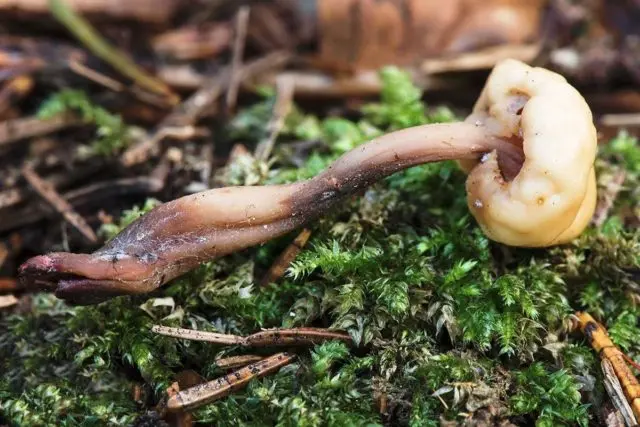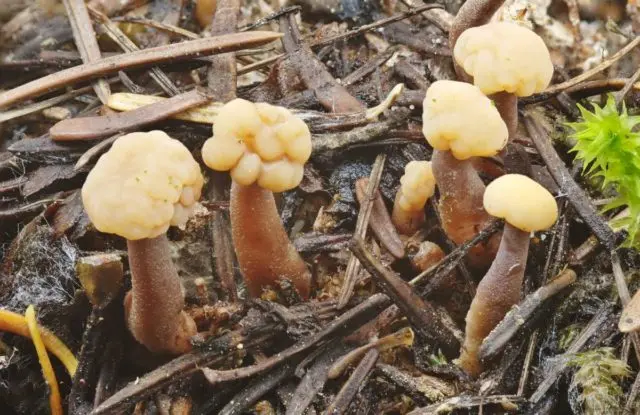Contents
Curled kudonia is an inedible representative of the Kudoniyev family. It grows from July to September in spruce, less often in deciduous forests. The species got its name because of the growth in swirling heaps. Since the mushroom is not eaten, in order not to make a mistake during mushroom hunting and not harm your body, you need to familiarize yourself with the external characteristics, view photos and videos.
What do twisted kudonia look like?
This forest inhabitant has a convex or prostrate-depressed hat with edges twisted inward. The surface is small, no more than 3 cm in diameter. The tuberculate-wrinkled skin is dry, dull, uneven, covered with mucus in wet weather and glistens in the sun. The hat is painted in coffee-pink, red-cream color, sometimes numerous small red-coffee spots appear on the surface. The creamy spore layer is uneven, rough, wrinkled closer to the stem.

The hollow leg expanding towards the top, flattened and curved, reaches a length of 5-8 cm. The surface is covered with thin skin, which is colored in the color of the cap, closer to the ground the color changes to a darker color. The pulp is fibrous, odorless and tasteless.

Where do twisted cudonii grow?
This representative of the mushroom kingdom settles heaps on coniferous needle bedding or in moss. Arranged in spiral groups or form “witch circles”. It can be found throughout Our Country, it begins to bear fruit from July to September. Reproduction occurs by microscopic spores, which are located in a creamy powder.
Is it possible to eat twisted kudonia
Due to the lack of taste, smell and unsightly appearance, the mushroom is considered inedible. But there is no exact information about the toxicity, so experienced mushroom pickers recommend passing by unknown specimens. This species has no edible counterparts, but there are brothers similar in appearance:
- Doubtful – inedible copy. You can recognize it by a small, unevenly tuberculate hat. Light lemon, cream or reddish skin is sometimes covered with dark spots. The surface is matte, but on a rainy day it becomes shiny and covered with a slimy layer. The curved leg is flattened, up to 5 cm long. The fibrous pulp exudes an almond flavor. It grows on a coniferous substrate, bears fruit from July until the first frost. The species is rare, rarely found in forests.
 Confused anemones – fungi kingdom
Confused anemones – fungi kingdom
- Leotia gelatinous – a small, inedible representative of the forest kingdom. The species grows in small families in coniferous forests, on a needle-like substrate. You can recognize the mushroom by its external description: a dark yellow, slimy hat up to 2 cm in diameter, when infected with parasites, the skin changes color to bright green. The rounded-hilly surface is covered with mucus, the gelatinous pulp is yellow-green in color, there is no smell and aroma. The leg is covered with light numerous scales; it grows throughout the warm period.

Conclusion
Curled kudonia is an inedible forest dweller who prefers to grow on a coniferous substrate or in moss. It starts fruiting from July to September. The fungus has not yet been fully studied, so the degree of toxicity is unknown. But experts recommend that if unknown specimens come across during a mushroom hunt, then it is better to pass by so as not to harm yourself and your loved ones.











